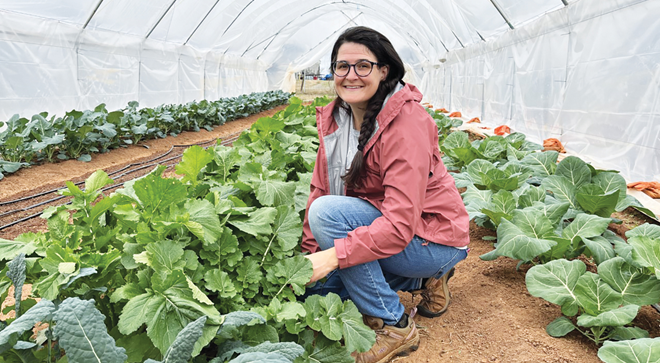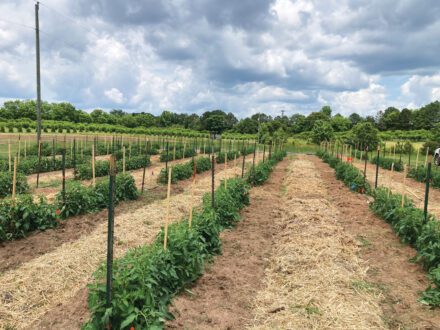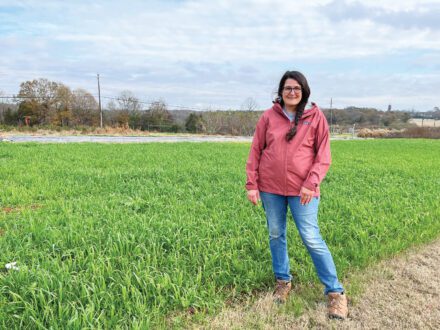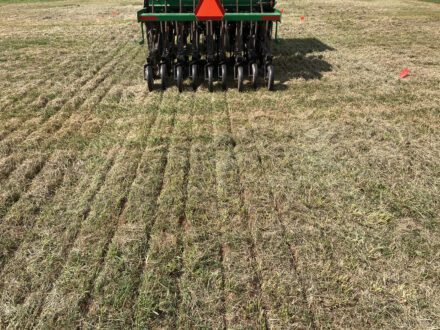
Dec 18, 2023Organic Grower: UGA studies transitioning fallow pastureland
To help new organic growers overcome weed challenges, University of Georgia College of Agriculture and Environmental Sciences’ researchers are examining ways to help transition land from conventional to organic production in the Southeast.
A UGA study, “Breaking New Ground: Reducing Perennial Weeds and Improving Soil Fertility for Southern Farmers Transitioning to Organic Production,” is supported through the USDA National Institute of Food and Agriculture organic transitions program.
Georgia ranks fourth in conventional fresh vegetable production in the U.S., but its 102 organic farms represent just 0.6% of the nation’s organic farms.

The study’s researchers want to find ways to help growers overcome challenges blocking organic growth and increase the scale of southeastern U.S. organic production, said Kate Cassity-Duffey, a UGA assistant professor of organic horticulture.
Cassity-Duffey, UGA’s Tim Coolong, a Department of Horticulture professor; and Nicholas Tuschak Basinger, an assistant professor of crop and soil sciences, are addressing weed management, soil fertility and organic matter, elements critical to organic production. The study began in late 2022 and is slated to end in 2025.
In the Organic Farming and Research Foundation’s 2022 National Organic Farmer Survey, growers ranked controlling weeds and nutrient management as top production challenges. Insect and disease control, particularly in the South, were other obstacles listed.
Conquering derelict land
Weed management in derelict soils, former pastureland that has remained idle for years, is being examined. Cassity-Duffey is studying how to more quickly transform derelict land into favorable soils for faster organic transitions. She said researchers plan to examine how cover crops can affect the weed community.
“We’re going to come up after these cover crops and see the kind of the severity of these weeds,” Cassity-Duffey said. “We also want to highlight how cover crops impact the soil fertility in ways that we can better bring them into vegetable systems. It’s combining what we know about cover crops and forages and bringing it to the vegetable world.”

Scientists are taking a systems approach, reviewing everything, including weeds, soil and crop health.
“We’re pulling on a lot of good research that has been done, but hopefully synthesizing it to something new,” she said.
Throughout the Middle Piedmont region around the metropolitan Atlanta area and in central Georgia, 25 cooperator sites are involved. Cassity-Duffey wants to convince growers who are acquiring larger acreages to use no-till drilling of cover crops. If they no-till one piece of their land for one season before their first cash crop, the new organic growers can build soil quality and carbon nitrogen which will aid with soil compaction issues. This could also help deplete weeds, with Bermuda grass being one of the biggest weeds.
Because there are limited organic herbicides available for vegetable production, growers have few resources for controlling weeds. Cassity-Duffey is primarily studying nitrogen, but also plans to look at phosphorus and potassium and wants to see how different cover crops, including legumes versus nonlegumes, affect soil nitrogen, carbon pools and weed communities. Researchers are studying warm and cool season cover crops.
Understanding southern soils
“If we can better understand those pools of fertility in our soils and how organic matter interacts with that, we can reduce fertilizer applications and increase the efficiency of organic production, and gain a better understanding of our southern soils,” she said. “How we build soil health in our southern soils has potential to scale-up organic production. It will also benefit our conventional growers.”

In what Cassity-Duffey calls a “black box,” because of nitrogen’s complexity, it’s difficult for scientists to consistently predict soil nitrogen availability.
“Many times, we just put out enough nitrogen to hit crop yields without seeing if there is any in the soil,” she said. “But, if we can figure out what the soil is contributing and what that organic matter is contributing, we can encourage people to build those nutrient pools and then cutback on fertilizer costs.”
Growers who purchase fallowed pastureland or know little of its history may be unsure of water trough locations or cattle movement areas that may have led to soil compaction. Understanding how cover crops can quickly break-up compaction layers and improve soil structure could hasten organic transition (the three-year transition process is set by the USDA) to profitable yields, Cassity- Duffey said.
After the Love is Love Cooperative Farm, a study collaborator in Mansfield, an hour east of Atlanta, recently procured a no-till drill, one of its growers noted how quickly he could plant cover crops seed using the implement.
“That’s another benefit of it, trying to show this tool that’s used in row crop production can be a tool for vegetable growers because he could plant cover crops much quicker than with other cover crop planting methods,” Cassity-Duffey said.
A grower can get into land that doesn’t require prepping and seeding, she said.

“With organics, it’s super complicated because they’re getting their nutrients from the soil from the cover crops,” Cassity-Duffey said. “And then we’re applying organic fertilizers. What we’re hoping to see is how much nutrients we are getting from these cover crops.”
The UGA Cover Crop Calculator predicts nitrogen release, then measures nitrogen availability over the season to determine how fertilizers, cover crops and soil organic matter contribute to the nitrogen pools.
A 2015 survey showed Georgia growers perceived organic production bringing lower yields combined with a lack of demonstrated success, which inhibited wider adoption of organic farming.
“I believe that we can increase organic yields and hit a lot of these conventional points a lot of the time,” Cassity-Duffey said.
It will be crop dependent, but there are other benefits to look at as opposed to only yield, she said.
“If we can help our organic growers increase those yields, but then also show conventional growers the yields we can hit, I do think we can get more organic production,” Cassity-Duffey said.
— Doug Ohlemeier, assistant editor
Top photo: Kate Cassity-Duffey, a UGA assistant professor of organic horticulture, is participating in the USDA and UGA study, “Breaking New Ground: Reducing Perennial Weeds and Improving Soil Fertility for Southern Farmers Transitioning to Organic Production.”
















